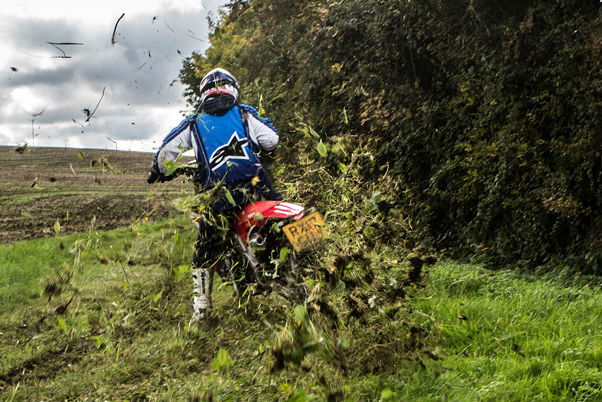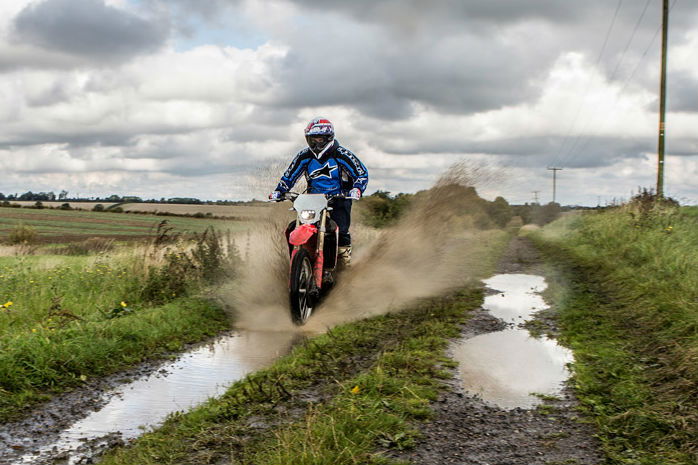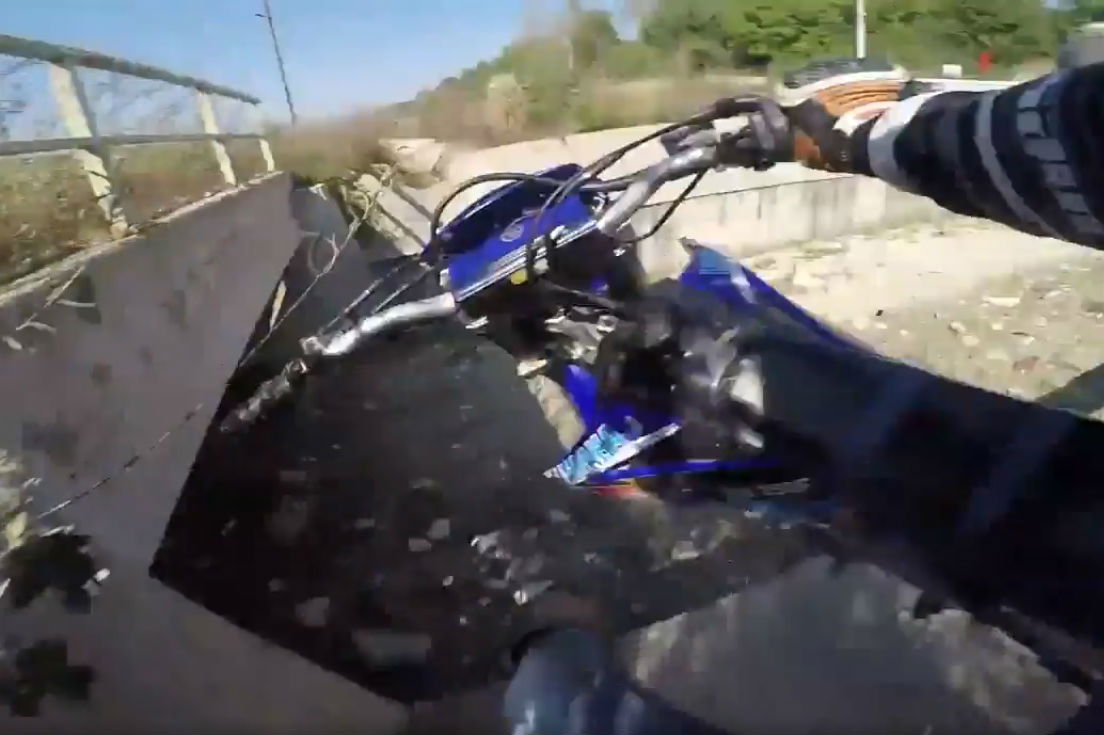Taming the beasts part two: Honda CRF450RX
In part two of his series of off-road tests, David Miller attempts to tame a Honda's big-bore enduro bike.

Words: David Miller
Pictures: Lorna Newman
HONDA has previous for barking, big-bore enduro bikes. Its 1988 XR600 was an off-road tool for mentalists only and the entirely-unhinged who converted them to road use for chip-shop wheelie shenanigans.
As with everything, polar bears and people with twigs in their beards saw the overwhelmingness - if that’s even a word - of silly motorcycles get less and less, and more and more user-friendly. Honda’s current piece of enduro lunacy, however, isn’t so far removed from the XR as Al Gore would have hoped for.
Honda's CRF450RX is an off-road bike, pure and simply. Okay, it has a light, some indicators, a number plate and a little electronic dash that lies to you about everything apart from the time. Its use on the road should only be to get from one green lane to the next as it will only do about 50mph - although according to the dash you’re doing 225mph at half-throttle in top - and on tarmac the tyres feel like they’re made from egg mayonnaise.
Give it some dirt, and it is a different story. Riding the CRF was approached with a little less caution than the KX250F of last time. By its very nature, the CRF should be a little less intimidating, a little less focused and a little less on the edge. And it is, but only a little.

Be warned now. If you have littler legs than me, one of these could be a struggle. At 5ft 9in, but with a 30in nuts-to-ground measurement, getting on the thing wasn’t as bad as it looked, but if you’re nearer Tyrion Lannister than Gregor Clegaine, then you might want to have a think. The two excellent pieces of news are a side-stand for when trees aren’t in evidence and electric start.
The engine is the same as you get in the full-blown motocrosser, as is the gearbox. First gear is tall-ish but that’s perfect for the slow and slippery you get on some green lanes and the power delivery is smooth, perfect for sitting in a higher gear for faster sections when your concentration should be on what the front wheel is doing - or not - and you can roll on and off without losing momentum.
The motor never feels very urgent, even at higher revs, but there is shove aplenty and more than enough to overwhelm the available traction at every given opportunity. However, as the bike is narrow and carries its weight relatively low, horrible near-injury experiences are few and far between when it comes to the rear letting go. There are three throttle maps available via the bar-mounted dash.
Mode one is the base map and provides a smooth, linear throttle response, making the engine’s power much more usable in a wide range of conditions. Mode two tones down engine performance for when you’re new to this or knackered, while mode three sets your hair on fire. The smart money would go on adapting your throttle control first on the base map before you start monkeying with it.
Response from the engine when the throttle is cracked is pretty-much immediate but there are no horrid holes or areas where the thing takes off without so much as a by-your-leave. It’s linear with a constant push right to the top of the range. That push does induce a lot of spin - it’s a lot of power on dirt so expect nothing else - but as with anything, the more you do it, the more natural it becomes and it’s fairly controllable to the point of being fun after half an hour behind the bars.
In all honesty, you’re more likely to lose the front if you’re a road-rider-turned-trailie, as you’re more likely to grab a big handful in an oh-shit situation. The front brake is a 260mm disc with two-pot caliper but with only 116kg (plus whichever standard of lard the rider has attained) to stop, it is easily up to the job. However, stopping is a lot more efficient if you use the engine more and brakes less, and it feels more natural after a while. Add some rear brake, too, to settle the whole thing down and do skids.

This method - which probably isn’t in the Stephane Peterhansel guide to off-road riding but works for me - also means your weight is naturally shifted forwards without overwhelming the front tyre should you have to grab the front brake when it’s brown-trousers time. For a big bike, the CRF feels light and agile.
It changes direction very quickly with little input but as a novice, stick to your rut and don’t try and get all Graham Jarvis. The throttle response makes it easier to get out of trouble as an injection of power will lighten the front and you can get it to go where it needs to, not where the surface is sending you.
You will get a sore bum. It’s part and parcel of riding off-road. The CRF’s seat isn’t plush by anyone’s standards but it is comfortable for an hour or so at a time if you’re not used to this sort of caper. Priced at around £8,000 with the speedo and light kit, constable, it’s a fair wedge for a toy.
But the thing is, it’s not a toy. The CRF450RX is a competition bike and feels like it. And sounds like it. It’s the sort of noise that makes kids wave and shout, and tweed-bedecked parish councillors tut into their pints of Old Sheepdog’s Anus.
I’ve no idea whether it’s value for money. I don’t really care. The CRF450RX is a whole bucket of off-road fun that, with the right accessories, means you don’t have to buy a van or a towbar and trailer set-up. Wheel it out of the shed, know where you want to end up, start it and go. If I had enough spare money I’d buy one.

Model tested: Honda CRF450RX
Price: £7,533
Engine: 449.7cc liquid-cooled four-stroke single
Kerb weight: 118kg
Seat height: 959mm
Ground clearance: 328mm
Tank capacity: 8.5 litres
CLICK HERE TO READ TAMING THE BEASTS PART ONE: KAWASAKI’S KX250F.

